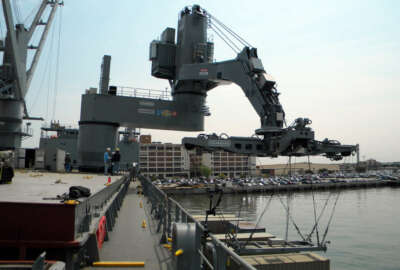
6 months in, Marines 5G base is working on autonomous vehicles and more
Marine Corps Air Station Miramar is planning on expanding its 5G coverage in the first four months of 2021.
In July, Marine Corps Air Station Miramar in California embarked on a trial to make it one of the most technologically savvy military installations in the nation, by teaming up with Verizon to introduce 5G.
Now, six months later, the base continues expanding its presence of 5G, and is adding more innovations to its 5G network. It continues to be a testbed for what the military can do with high bandwidth data from satellites.
Miramar has turned on two of its planned 26 5G nodes on base that provide network access.
“People can think of a 5G node as being a very high performing node, that’s actually external to where you would normally put a WiFi router, and really connected in with a cellular network cellular provider,” Marine Corps Lt. Col. Brandon Newell, director of the Southern California Tech Bridge for NavalX, told Federal News Network. “The challenge, as you design a network, is that I know that I need very high performing nodes of connectivity where I can handle a lot of systems that are connected. They are pushing lots of data, and more nodes will allow very low latency in, in how that data is transferred.”
The Marine Corps plans to have the rest of the nodes up in the first four months of 2021.
As the 5G network grows on the base, the Marine Corps is working on four different missions.
One is using the network to save energy. Miramar is one of the leading bases using microgrids — decentralized groups of electric sources like a wind turbine that powers only one house. Newell said 5G will be used to make decisions on how the Marine Corps connects and controls capabilities to microgrids for energy efficiency.
Miramar is also working on autonomous vehicles for the base, which will tap into the 5G infrastructure.
“It’s a vehicle where the all the brains and the eyes are not just on board, but that vehicle is able to connect to infrastructure or connect to other vehicles to really expand its sensing and processing of the environment,” Newell said. “It’s a really leap forward into unmanned systems that we’re very excited about and watching across the market.”
It’s not just land vehicles that are getting the 5G treatment. Drones will be coming off the radio frequencies and working through cellular data.
Finally, 5G is going to permeate through base security to create what the Marines call a digital fortress. The network will help with artificial intelligence and machine learning sensors suites to learn patterns to better security.
The Defense Department as a whole is putting large investments in 5G. Last October, it announced $600 million 5G contracts for five new bases, bringing the grand total of bases experimenting with new networks to 17.
“Working in close concert with industry, we’re using these test sites to accelerate US 5G leadership and ensure the department benefits the new applications enabled by this technology,” said Michael Kratsios, acting undersecretary of defense for research and engineering. “Moving forward, the department will continue to focus on large scale experimentation prototyping of dual use 5G technology for military and commercial purposes. The sandboxing activities on military bases harness the department’s unique authorities to pursue bold innovations in game changing technologies.”
DoD plans to begin testing at seven more bases this year.
In October, Miramar held a 5G Pitch Day, which awarded about $200,000 to startup companies to test and pilot technologies on base.
The companies will work within the missions the Marines have outlined or bring in their own ideas. For example, GenXComm works on bettering network and computer efficiency.
Because of COVID-19, NavalX will be going out to visit the companies this year to update plans.
As for challenges, Newell said the biggest issue is wading through the DoD’s bureaucracy.
“We started this effort with Verizon in 2018,” Newell said. “Jumping through all of the hoops that are required to do something new is daunting. We call it maneuver against the bureaucracy and conducting maneuver warfare against our own bureaucracy to unlock the future. That’s always the number one challenge.”
Newell said there have been a lot of approvals needed to set up all of the nodes on base.
He added that one of the benefits of working with the private sector is seeing how Verizon works with 5G and sets it up. It gives the military better ideas on enhancing 5G, setting it up and making the process easier.
Copyright © 2024 Federal News Network. All rights reserved. This website is not intended for users located within the European Economic Area.
Scott Maucione is a defense reporter for Federal News Network and reports on human capital, workforce and the Defense Department at-large.
Follow @smaucioneWFED






